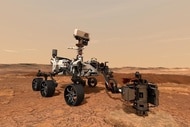Create a free profile to get unlimited access to exclusive videos, sweepstakes, and more!
Blast off in real time with the transparent guts of history's most famous rockets

You know when they say, “it’s not rocket science”? Well, that doesn’t apply at all to this intoxicating new video from Hazegrayart, which accurately animates the launches of four of the most important rockets in spacefaring history (and its future) in all their transparent glory, thus showing us the guts of what makes ‘em go higher, faster, and further.
In the video below, narrated by NASA’s finest, Hazegrayart removes the blast doors from (left to right) NASA's Saturn V, the Space Shuttle, SpaceX's Falcon Heavy rocket, and NASA's Space Launch System (SLS) to expose real time fuel burn and staging from Kennedy Space Center Launch Complex 39. In doing so, you can see how vastly different each rocket utilizes quantities of Kerosene RP-1 (as denoted in red), Liquid Hydrogen LH2 (Orange), and Liquid Oxygen LOX (Blue). You can also see the Solid Rocket Boosters employed by both the Space Shuttle and SLS.
Pretty impressive right? And intoxicating too. Like being hypnotized by an aquarium (we can’t be the only ones losing ourselves these days in the Monterey Bay Aquarium live feeds).
Noting the different configurations and fuel consumptions of the various rockets in the video is certainly interesting, but when viewed alongside the timing of the staging and the actual audio from the four launches, your brain really starts to explode.
For comparison’s sake NASA's 363-foot-tall, three-stage Saturn V, which lifted the Apollo astronauts moonward and beyond, weighed over 6 million pounds and could lift some 130 tons. Meanwhile, the 184-foot-long Space Shuttle — which according to Popular Mechanics “traveled 537,114,016 miles over the course of 134 flights” between Columbia, Challenger, Discovery, Atlantis, and Endeavor missions — could handle a maximum payload of 55,250 pounds. SpaceX's Falcon Heavy, the most powerful rocket working today, comes correct with game-changing reusable first stage boosters, stands 229.6-feet tall, weighs more than 3 million pounds, and “can haul a 140,660-pound payload to low-Earth orbit and a 37,040-pound payload to Mars.” And finally we have the SLS, the rocket powering the upcoming Artemis Moon mission, which stands 212-foot-tall at its core stage, Block 1, and “can haul about 209,439 pounds into low-Earth orbit and over 57,320 pounds to the lunar surface.”
Sure, the airspeeds of these four rockets wouldn’t keep them close, but is it too much to ask for actual rocket drag racing sometime in the near future? It could be the new live sport of this socially distanced age. NASA, can we get this going please?
(via Popular Mechanics)


























